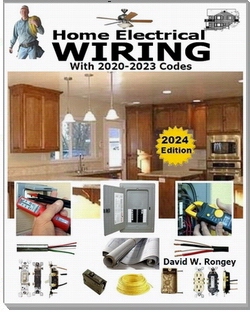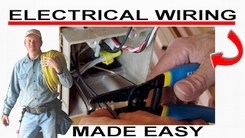» Generator Transfer Switches and Hook Up Portable Generator
» Need Electrical Help? Ask the Electrician
Generator Safety

|
Summary: Consider these guidelines to help understand if a portable home generator is a good idea for your home. © By: Dave Rongey |
Generator Safety: Is a Portable Generator a Good Idea?
Considering a Portable Generator
While a properly sized portable home generator may work fine for for your home, make sure the method that you use for powering up your home will be done safely by considering the following information.
Some customers prepare for the possibility of power outages by buying an electric generator as a standby system to keep lights and appliances running until service is restored. Home generators may be able to save food in your refrigerator or freezer during a prolonged outage, let you keep your home office running, or power other essential equipment.
Generators can be expensive and noisy. They can also pose serious safety hazards to you and to others, so please follow all safety instructions provided by the manufacturer.
The law requires that customers with a permanently installed or portable generator do not connect it to another power source, such as your Electric Utility Company's power lines. If you own and operate a generator, you are responsible for making sure that electricity from your unit cannot "back feed," or flow into the utility power lines. For safety's sake, be sure to use your generator correctly. If you don't, you risk damaging your property and endangering your life and the lives of electrical utility line workers who may be working on power lines some distance from your home.
Permanent Stand By Generators |
|
|
When a home generator is permanently connected to a customer's electric system, it energizes the building's wiring. This type of installation requires a device that prevents the generator from being connected to the electrical utility's power lines. |
|
Consider these Generator Safety Tips |
|
|
IMPORTANT:
Portable Home GeneratorsPortable home generators are designed to be connected only to selected appliances or lamps. These generators never should be connected directly to a building's wiring system. |
|
The Safest Way to Test Electrical Devices and Identify Electric Wires!The Non-Contact Electrical TesterThis is a testing tool that I have had in my personal electrical tool pouch for years, and is the first test tool I grab to help identify electrical wiring. It is a Non-contact tester that I use to easily Detect Voltage in Cables, Cords, Circuit Breakers, Lighting Fixtures, Switches, Outlets and Wires. Simply insert the end of the tester into an outlet, lamp socket, or hold the end of the tester against the wire you wish to test. Very handy and easy to use.
The Quickest Way to Check for Faulty Electrical Wiring!The Plug-In Outlet TesterThis is the first tool I grab to troubleshoot a problem with outlet circuit wiring. This popular tester is also used by most inspectors to test for power and check the polarity of circuit wiring. It detects probable improper wiring conditions in standard 110-125 VAC outlets Provides 6 probable wiring conditions that are quick and easy to read for ultimate efficiency Lights indicate if wiring is correct and indicator light chart is included Tests standard 3-wire outlets UL Listed Light indicates if wiring is incorrect Very handy and easy to use.
Strip Off Wire Insulation without Nicking and Damaging the Electric Wire!The Wire Stripper and Wire CutterMy absolute favorite wire stripping tool that I have had in my personal electrical tool pouch for years, and this is the tool I use to safely strip electrical wires. This handy tool has multiple uses: The wire gauges are shown on the side of the tool so you know which slot to use for stripping insulation. The end of the tool can be used to grip and bend wire which is handy for attaching wire onto the screw terminals of switches and outlets.. The wire stripper will work on both solid and stranded wire. This tool is Very Handy and Easy to Use. |
||















